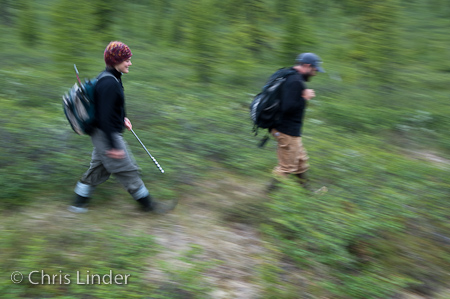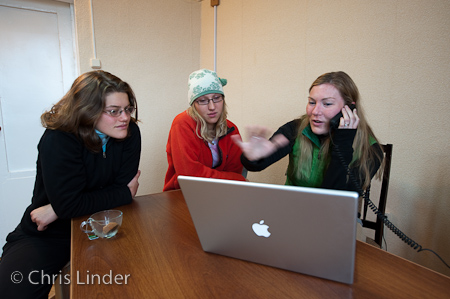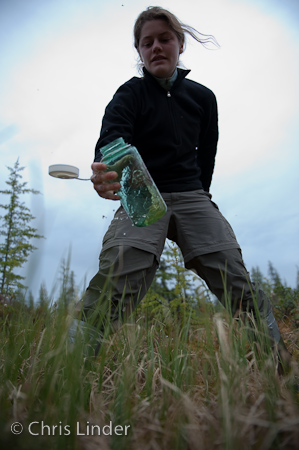When I started this post it had been a while since anybody wrote. Then I got distracted and things changed. But I guess this is still relevant, so here’s what I have to say. It’s been a very busy few days. Everybody’s been running around trying to get our data collection started. It’s hard, and as many of us are finding, sometimes you collect data and start trying to analyze it only to discover that it wasn’t quite what you wanted. So then, of course, you get to go back out and start all over again. But the good news is that we’re learning. Hopefully all of us will soon have our methodologies figured out and will be collecting data in earnest!
As far as my project is concerned, things are going pretty well. I’ve been going out collecting soil and pore water samples in alases (these are old thermokarst lake basins where the water has drained away and left wetlands). This is really interesting (and no, I’m not just biased because I have a weird fascination for peatlands) because these areas are the sources of the carbon and nutrients that we are studying in the streams and lakes in the area. As water flows through these soils it absorbs carbon and carries it as it flows into streams, rivers, and eventually the ocean.
But why, you might ask, does anybody besides a half-crazed moose-eating ecologist care about all of this? Believe it or not, that’s a question we think about quite a bit up here. In fact, it’s so important for people to understand this that Karen has been waking up early (around 5 am our time!) to talk to audiences in the United States (via satelite phone) about just this question. Yesterday Erin and I got to sit in on her presentation and it gave us a lot to think about. Karen told us a lot about thawing permafrost in Arctic ecosystems is causing major land upheavals and releasing carbon from ancient soils into rivers and, eventually, the ocean.
You see, understanding Arctic ecosystems isn’t just some obscure academic pursuit. It’s actually extremely important if we are going to learn how climate change is going to impact the rest of the world. I know if you’re sitting there in Pittsburgh PA it doesn’t seem very likely that carbon from an Arctic peatland is ever going to have an impact on your life. But the Earth is smaller than you might think. When carbon is released into aquatic ecosystems it is consumed by microbes which release carbon dioxide which, of course, feeds right back into the climate changes that are causing month-long rainstorms in the eastern United States. So what’s the big deal about a little extra rain? Climate change isn’t just about annoying weather. Too much rain causes crops to rot in the ground – as they have been on many farms this summer. And that decreases the quality and availability of produce while increasing prices in your local supermarket. And if you happen to be one of the farmers who can’t sell the rotten vegetables you’ve been working so hard all summer to grow, finances might be starting to look pretty dicey, too.
But if we can understand the changes taking place in arctic carbon cycling maybe we can predict the scale of the changes taking place and figure out how to do something about them. So, that’s a rather long-winded summary of what I’ve been thinking about recently. I hope it’s more interesting than it is intimidatingly long.
Peaty and satisfied,
Moira







Comments(2)-
Monique Kantor says
July 13, 2009 at 5:38 amThis blog hit home as “Minnesota has about 7 million acres of peatlands, the most of any state in the Lower 48. Even though large expanses of them have been drained for farming, they are still the state’s largest intact original ecosystem and perhaps its largest wilderness. Peatlands cover about 14 percent of the state’s land area, but they hold 37 percent of its stored carbon, the highest of any land or vegetative form.” This taken from an article I found at: http://www.startribune.com/local/13581681.html as I am aware that this issue is of great concern to environmentalists here in Minnesota.